|
Comments welcome : charlie@davenportstation.org.uk |
Loco-hauled passenger trains in the Innviertel, 2007
All Mondays - Fridays only
Class 2016
5967 06:30 Braunau - Neumarkt-Kalham 07:31
5804 05:49 Braunau - Salzburg 07:06
5823 16:38 Salzburg - Braunau 17:52
5964 06:21 Wels - Simbach 07:44
5920 14:02 Braunau - Steindorf 14:50
5819 15:03 Steindorf - Braunau 15:49
5824 16:02 Braunau - Steindorf 16:51
5962 06:20 Neumarkt-Kalham - Braunau 07:18
5975 13:02 Braunau - Neumarkt-Kalham 13:58
5974 14:13 Neumarkt-Kalham - Simbach 15:17
5987 15:23 Simbach - Braunau 15:26
5979 15:52 Braunau - Neumarkt-Kalham 16:49
5982 18:08 Neumarkt-Kalham - Braunau 19:12
5985 19:57 Braunau - Wels 21:22
5800 04:30 Braunau - Salzburg 05:50
5963 05:12 Braunau - Linz 06:54
5890 16:41 Linz - Braunau 18:23
Class 2043 (passenger)
5803 06:28 Steindorf - Braunau 07:25
5991 13:56 Braunau - Neumarkt-Kalham 14:53
5990 16:35 Neumarkt-Kalham - Braunau 17:50
5828 17:58 Braunau - Steindorf 18:47
5827 19:00 Steindorf 19:00 - Braunau 19:53
Freight workings
One 2043 loco is stationed at Steindorf for trip workings as required to Strasswalchen (07:05, arrive back 07:50), Seekirchen (13:08 - 14:09), Munderfing (08:11 - 09:00) and the car import
sidings at Steindorf-Friedburg (several trips between 10:10 and 18:32)
One 2043 loco works 79812 Grieskirchen-Gallsbach - Neumarkt-Kalham 06:35, then 79830 Neumarkt-Kalham
- Scharding,then local trips around Scharding until it returns with 79835 14:05 Scharding - Neumarkt-Kalham 15:31/16:30 - Grieskirchen-Gallsbach 16:54/17:26 - Wels marshalling yard.
Also booked for a 2043 is 45847 16:26 Simbach - Braunau 16:32/17:23 - Wels 19:34
A 2016 can be found at Steindorf in the mornings:this perhaps also works trips to the car import sidings.
Braunau has a Class 2070 station and yard pilot which shunts freight and passenger vehicles, and runs trips to the aluminium works on the Ramshofen branch.
Lights on...
There was something I wanted to check for the authenticity of my DCC-worked model railway operation. When a loco runs round at a terminus like Braunau, what colours do the headlights show during the various moves?
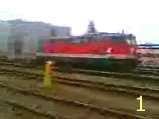
The thumbnails are links to three more mobile phone videos converted to wmv format. Clip (1) shows the loco running back round the train after drawing forward onto the line towards Simbach. Note that the three white headlights remain lit as the loco runs in reverse; not possible with the standard wiring of a DCC-fitted loco.
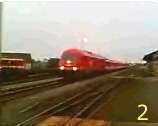
In clip (2), while the loco waits to return to the train, the 2016-hauled 16:38 through train from Salzburg, due at 17:52, arrives.
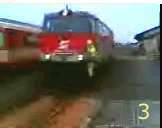
Clip (3) shows 025 returning to its train, headlights at the Simbach end still showing and the shunter making use of the step and handrail provided for the purpose. Unfortunately I failed to note what lights, if any, were showing at the other end of the loco during this move. Can anyone help?
Mattighofen and the Innkreis: March 2007

Mattighofen, in Upper Austria, is perhaps not a place that a typical tourist would take a holiday, although (like many in Austria) it is a rather pleasant little town, as the picture above shows. Our visit developed from the discovery that in the December 2006 - December 2007 timetable there were still a handful of passenger workings for the Class 2043 diesel-hydraulic locos built for the ÖBB in the 60s and 70s.
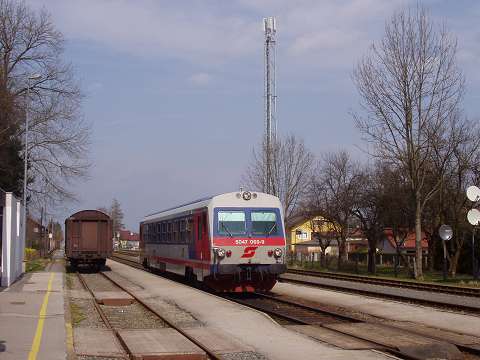
Mattighofen lies around about the mid-point of the branch line which runs from Steindorf bei Straßwalchen on the Salzburg - Linz main line to Braunau am Inn. Radio mast aside, Mattighofen station (above) has the traditional layout of an Austrian passing station, although its low platforms built up a little to aid passengers, and goods facilities nearest to the station building. If it had any signals, they had been dispensed with, all dispatch of trains now being by radio. Most of the services on the branch were worked by Class 5047 railcars like 5047 069-9 seen here. 100 of these were built in the early 1990s by Jenbacher Werke, and once you have climbed the steep steps to get aboard, they are very much the equal in comfort of any main line coach.
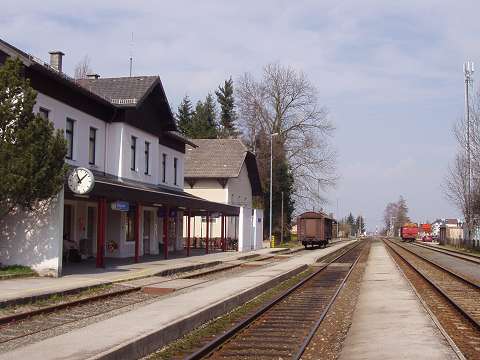
Another view of the station, showing the station building which is of traditional style, but with a little modernisation around the canopy area. It was staffed all the time trains are running, with half-hour breaks at advertised times while the stationmaster gets meals and did other work. He sold tickets, saw every train away, and also operated the level crossing barriers at each end of the station, which are cable operated by motors located under the canopy.
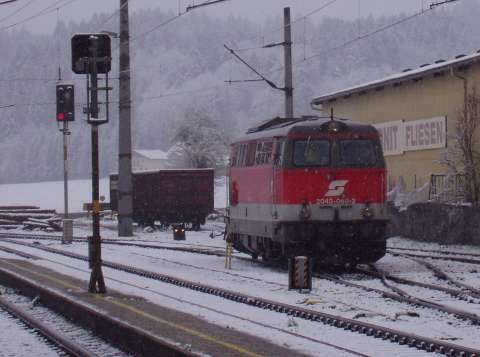
Monday 19 March was our appointed day for some train-chasing, and to our dismay we awoke to a snowstorm. However, we caught the 09:24 train from Mattighofen to Steindorf bei Straßwalchen to see if the 2043 allocated to local freight trips was anywhere in view; and sure enough there it was, 2043 068-2, lurking awkwardly in the stabling sidings west of the station. I managed this picture by crossing to the platform as though I was joining a Salzburg-bound main line train....
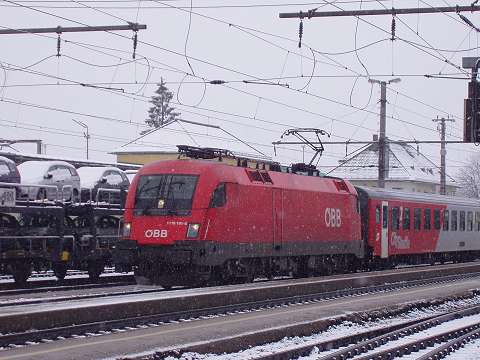
'Taurus' electric 1116 191-6 arrived on an eastbound Regional Express working from Salzburg to Attnang-Puchheim. These new locos worked many of the trains, although older 1142s were also seen. The usual formation is a push-pull set of five City-Shuttle coaches, which were converted from vehicles originally built for longer-distance workings are are extremely comfortable and spacious, especially compared with the type of train found on a similar working in Britain. These trains ran hourly call at major stations only: an hourly all-stations service is provided by the impressive new 'Talent' railcar sets as part of the Salzburg S-Bahn network.
In the marshalling sidings behind is a rake of car carriers: these were a very common sight here, as just a short way up the Braunau branch was the business of a car importer, with stocks of new cars occupying a huge acreage of ground. Because that line is not electrified, a diesel loco was needed to take over the car trains for the last lap of their journey, requiring several trips per day.

After 20 snowy minutes at Steindorf we caught the same railcar back, this staying on the train through Mattighofen and all the way to Braunau. At Munderfing, the station before Mattighofen, the building was still in its original form without a canopy. Freight was handled here, mostly timber from the nearby Korneuberg forest, with a booked visit each morning from the 2043.
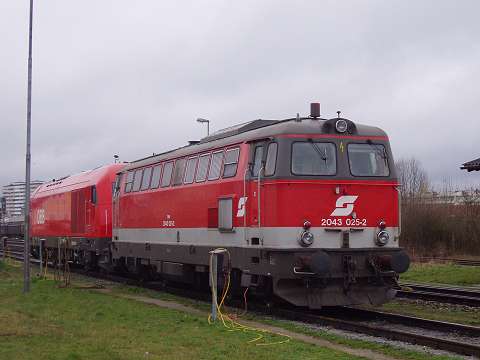
Braunau am Inn was a relatively busy station: the line from Steindorf here joins the branch from Neumarkt-Kalham (On the Wels - Passau main line), and a continuation across the Inn into Germany, of which more below. The chief source of freight traffic was the Aluminium works at Ramshofen, served by a 5km-long freight-only branch from Braunau, and rakes of Cargowaggon vans and open wagons loaded with aluminium ingots fill most of the sidings. British railfans will know that some of these came by rail at that time from the Anglesey Aluminium Metal plant at Holyhead.
A road runs alongside the station and crosses the station throat by a level crossing, giving excellent views of the loco stabling area. Here we see 2043 025-2, which would be our traction later in the day, having its batteries charged, and the contrasting shape of modern 'Hercules' diesel-electric 2016 071-9 behind. Many shunting moves require the level crossing barriers to be lowered, so take care where you stand!
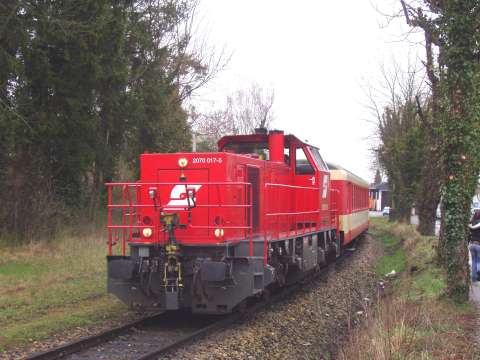
Braunau has a 'station pilot' - on this day 2070 071-5, a recently-built Vossloh loco of a type sold to various European railways, complete with a coupler controlled from the cab. Here it is, assembling for the stock for the two loco-hauled trains which ran to take home the schoolchildren in the early afternoon. It is here standing on the line which continues alongside beyond Braunau station towards the bridge over the river Inn.
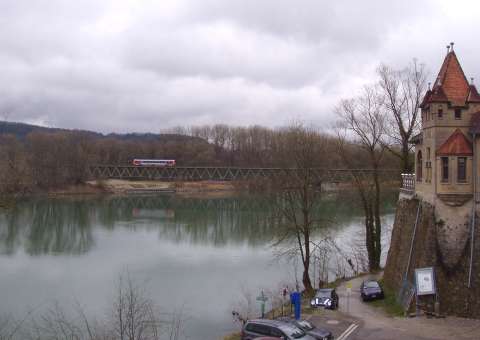
From just by the road bridge over the Inn at the lower end of Braunau town square, there's a good view of the old town walls (right) and the Inn bridge itself, seen here with the 5047-worked 11:47 from Simbach am Inn (the Bavarian town on the other side) making its way across. Simbach is the terminus of Deutsche Bundesbahn trains from Munich via Mühldorf; only occasionally do German locos venture across. At this point we took to our feet to explore the footway (also a cyclepath) which mostly follows the riverbank down towards Passau, and visit a couple of the intermediate villages on the line towards Neumarkt-Kalham.
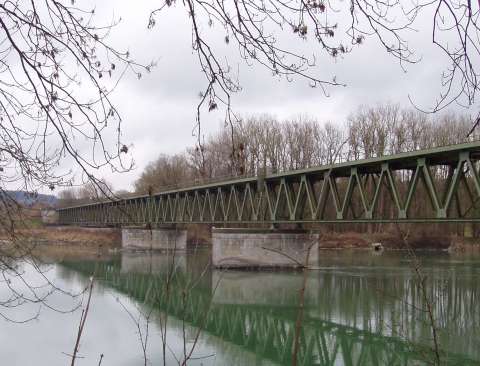
The path passes under the railway bridge, a very lightweight-looking structure which was built to replace the original bridge was destroyed by the German army near the end of World War II.

The path follows the Inn as it widens into a lake known as the Hagenauer Bucht, which now forms part of a peaceful nature reserve called the Europareservat.
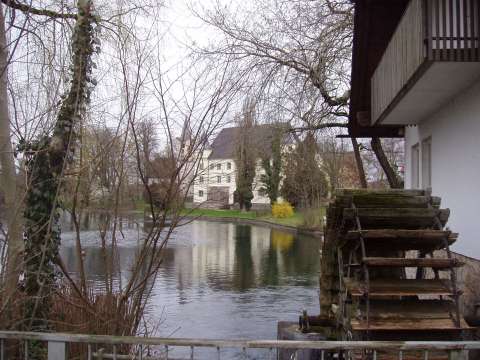
We parted company with the river at the picturesque Schloss Hagenau (above) , with its old watermill, and headed though quiet lanes to Hagenau station, the first station east of Braunau, which is actually located a couple of kilometres away in the village of Bogenhofen.
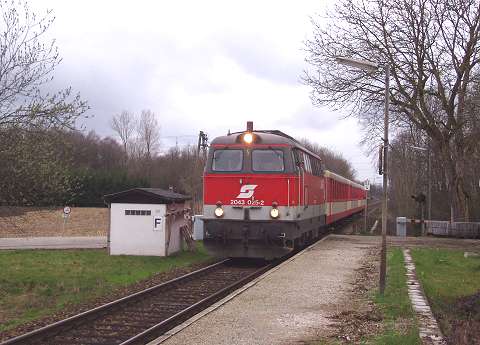
Just in time (spent a smidgeon too long watching the birds) we arrived at the unstaffed halt of Hagenau im Innkreis to catch the 13:56 Braunau - Neumarkt-Kalham, as expected made up of 2043 025-2 and three coaches. What a way to travel!

We travelled on this train just as far as the next station, Mining, a very modern-looking halt: the 2043 heads off with its rake of 'Schlieren' coaches. From here we walked back to the river to explore some of the reserve on the Bavarian side of the river.
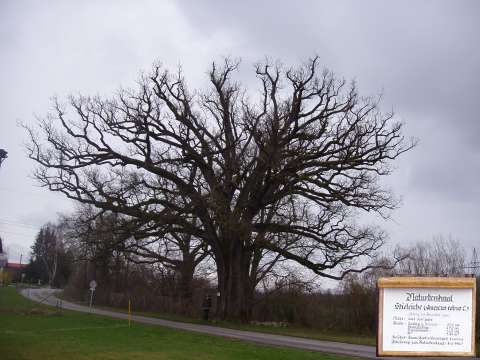
On the way, we passed this majestic 300-year-old oak tree: inset in the picture the 'naturdenkmal' board attached, which tells us that it has a circumference at chest-height of 5.25 metres Just visible is my wife Joanna giving scale to the view. Oaks are a great love of ours, as we have a somewhat younger one, maybe 150 years old, in our front garden.
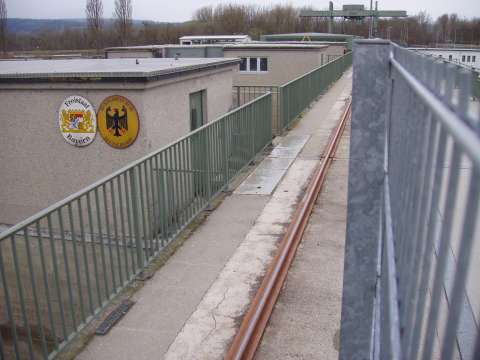
The path crosses the national border in a most unusual manner: across the dam of the Ering hydro-electric power station. The plaques on the wall of the nearest turbine house mark the Bavarian - Austrian border, although when the station was constructed in 1939-42, both sides were in Germany. The single rail in the picture is one of a pair which carry the gantry cranes to remove the turbines as required for maintenance.
There is a visitor centre for the nature reserve on the German side, a short way up the road towards Ering village, but it is only open at weekend in winter. There is, however, an interesting nature trail with bird-watching hides provided, which takes you through the woods, and back via Simbach to Braunau if you want, but we had an appointment with a 2043 back at Mining station...
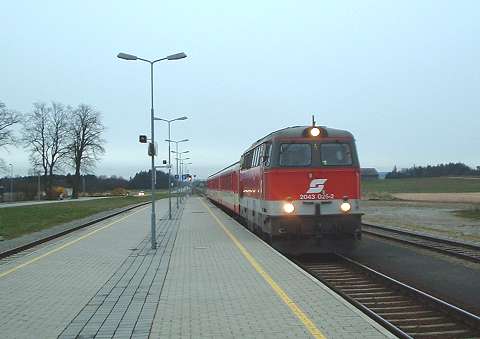
... and here's Joanna's view 025 arriving back from Neumarkt-Kalham to take us back to Braunau.

After arrival at Braunau at 17:50. The locomotive ran round here to form the 17:58 to Steindorf, on which we returned to Mattighofen.
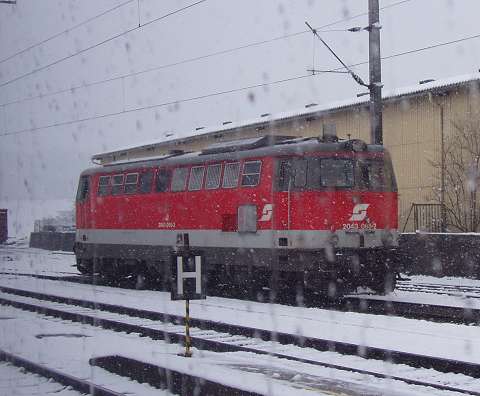
Next day, and a trip to Salzburg, changing at Steindorf, where freight trip loco 2043 068 is on duty again, and posed in a more photogenic position. Shame about the snow, which continued more or less all day.
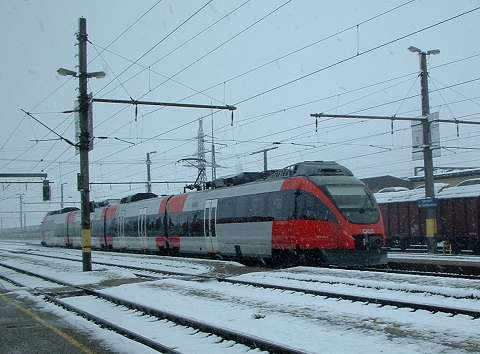
We decided to ignore the Regional Express connection, to wait for the new 'Talent' unit on the all-stations Salzburg S-Bahn service ten minutes later. This train has started from Straßwalchen and would reverse at Salzburg to continue to Golling-Abtenau. We were very impressed by the interior of the articulated train and the automated information system, but sadly there is no forward view. (Picture by Joanna)
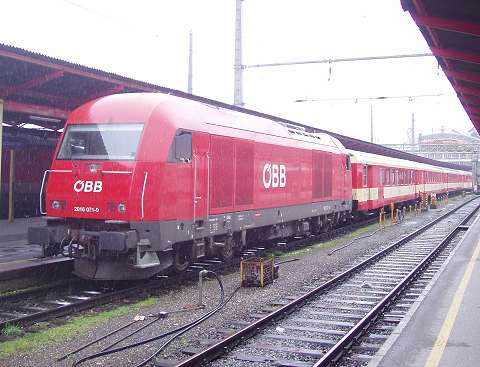
After a day in museums, we returned to Salzburg Hbf to catch the four-coach 16:38 to Braunau, hauled by 'Hercules' 2016-071-9.
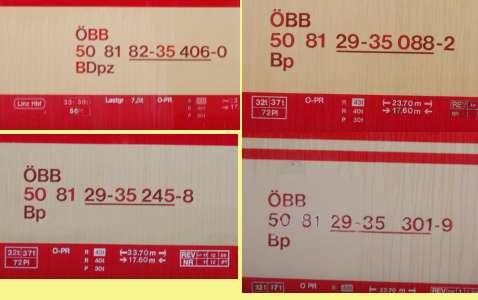
As a hint for modellers, here are the numbers of the coaches. All four are in the second version of the orange and cream livery, except for 35 301, the rear coach of the train, which still has the first version.

At Steindorf, we overtook 2043 068-2 standing in the Braunau line bay platform at the head of a rake of coaches. This would be the next day's 06:28 to Braunau, so we managed to photograph four of the five surviving Class 2043-hauled passenger trains, and travel on three of them. Could I have had my very last journeys behind a 2043? I said the same back in 2004, so who knows?
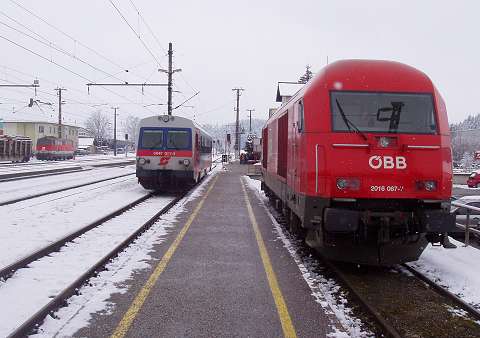
Next day, Wednesday, and a last look at Steindorf as we head back to Salzburg and the airport. All three of the types of traction normally seen on the Mattighofen line, captured on one view. 2043 068-2, 5047 087-1 and 2016 067-7. Wagons of timber in evidence on the left: some of the timber wagons noted at Mattighofen seemed to be bringing in timber, perhaps hardwoods to supplement the local conifers, from eastern Europe.
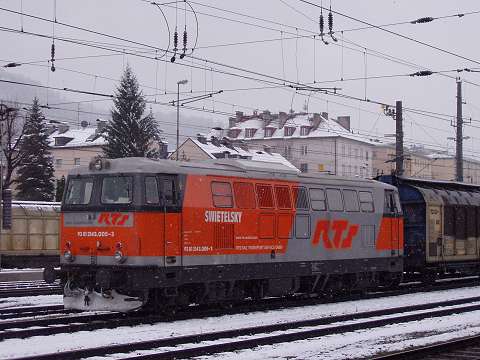
An interesting sight at Salzburg station: a long freight train hauled by an ex-ÖBB Class 2143 diesel-hydraulic, now owned by open-access operator RTS and bearing its full international number 93 81 2143 005-3. The 2143s were built by SGP to the same specification as the Jenbach-built 2043, but have a different engine and other technical differences: the easiest recognition point is that they have the rood 'pod' containing the nearer to the centre of the centreline of the loco, and below it, three ventilation louvres below the waistline.

We had a few hours in Salzburg before catching the plane, and fortunately the snow stopped, so we headed for the castle where we were able to get some very picturesque views. This one shows the old town, with Cathedral in the centre foreground and the Salzach river behind.
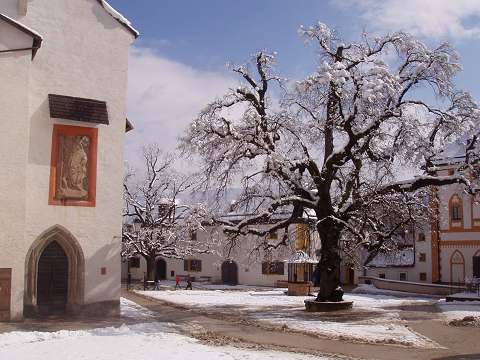
Old lime trees dominate the castle courtyard.
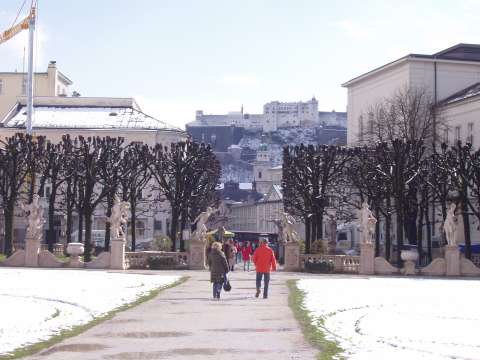
Down in the city, the Mirabelle Gardens, with the castle on the skyline.
So farewell to Salzburg and the Innkreis, with thanks to everyone who helped make the trip a success: Sky Europe Airlines (which has sadly ceased to exist), the people from the Austrian Railways Group who are always so helpful were with information and moral support, the lovely people at Elfi's Gästehaus and the Casa Verona restaurant, Mattighofen, and of course all the local staff of the ÖBB Innkreis lines who put up with our attempts at German and my popping up taking their pictures all over the place.
Page created by Charlie and Joanna Hulme, April 2007. Updated April 2011.